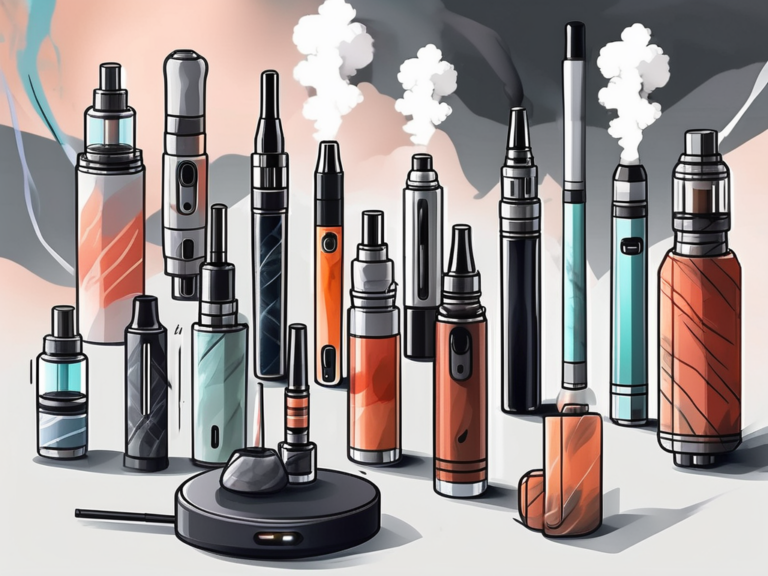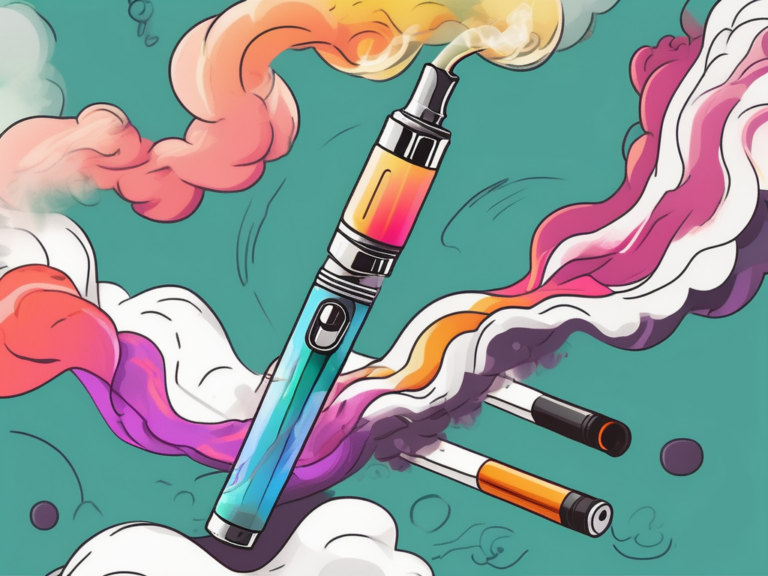when were vapes made
Vaping has become an increasingly popular alternative to traditional smoking in recent years. Many people are curious about the origins of vapes and how they have evolved over time. In this article, we will delve into the history, science, and legal aspects of vaping to provide you with a comprehensive understanding of this modern phenomenon.
Understanding the Concept of Vaping
Vaping is the act of inhaling and exhaling vapor produced by an electronic device called a vape. These devices are designed to simulate the experience of smoking without the combustion of tobacco. Vapes typically consist of three main components: a battery, a heating element, and a reservoir to hold the e-liquid.
The Basic Components of a Vape
The battery is the power source that activates the heating element. It can be recharged and is usually the largest part of the device. The heating element, known as the atomizer or coil, heats up the e-liquid, converting it into vapor. The reservoir, often called a tank, holds the e-liquid, which is a mixture of propylene glycol, vegetable glycerin, flavorings, and nicotine (in varying concentrations).
One interesting aspect of the heating element is that there are different types of coils available, each affecting the vaping experience in unique ways. For example, some coils are designed for enhanced flavor production, while others prioritize vapor cloud production. Vapers can experiment with different coil types to find the one that best suits their preferences.
Different Types of Vapes
Vapes come in a variety of forms, catering to different preferences and needs. Some of the most common types include cig-a-likes, vape pens, and box mods. Cig-a-likes resemble traditional cigarettes both in appearance and size, making them a popular choice for beginners. Vape pens are larger and more powerful, offering a greater variety of features and customization options. Box mods are even more advanced, allowing users to adjust settings such as wattage and temperature.
Aside from the traditional types of vapes mentioned, there are also specialized devices such as pod systems and mechanical mods. Pod systems are compact and easy to use, often favored for their convenience and portability. On the other hand, mechanical mods are unregulated devices that appeal to experienced vapers looking for full control over their vaping experience. The diverse range of vape devices available ensures that there is an option suitable for every individual’s vaping style.
The History of Vaping
To truly understand the history of vaping, we need to take a trip back in time.
Vaping, as we know it today, has a rich and fascinating history that dates back several decades. The concept of inhaling vaporized substances can be traced back to ancient civilizations that used hot stones to create aromatic vapors. This practice evolved over time, eventually leading to the invention of modern vaping devices.
The Early Beginnings of Vaping
The concept of vaping can be traced back to the 1960s when a man named Herbert A. Gilbert patented a device that heated a flavored liquid and produced a flavored vapor. Gilbert’s vision for a smokeless non-tobacco cigarette was truly ahead of its time. Despite his groundbreaking invention, Gilbert’s device did not gain widespread popularity due to the lack of technology and public awareness at the time.
Fast forward to the 21st century, and vaping has become a global phenomenon with a diverse range of products and flavors to choose from. The evolution of vaping devices has been a remarkable journey, with constant innovations and advancements in technology shaping the industry.
The Evolution of Vaping Devices
It was in the early 2000s that a Chinese pharmacist named Hon Lik revolutionized the world of smoking by inventing the modern e-cigarette. Hon Lik’s personal experience of losing his father to lung cancer fueled his passion to create a safer alternative to traditional cigarettes. His invention, which used a heating element to vaporize a liquid solution, quickly gained traction in the market and paved the way for the vaping industry as we know it today.
The Rise of Vaping Popularity
In recent years, vaping has experienced a surge in popularity, especially among younger demographics. This rise can be attributed, in part, to its portrayal in popular culture and aggressive marketing campaigns.
One significant factor contributing to the popularity of vaping is the perception of it as a safer alternative to traditional smoking. Many individuals view vaping as a way to satisfy their nicotine cravings without the harmful effects of combustion and tobacco. This perception has led to an increase in the number of people, particularly former smokers, turning to vaping as a potentially less harmful habit.
Vaping and Pop Culture
Vaping has become a prevalent trend in movies, TV shows, and music videos, often portrayed as a cool and rebellious act. This portrayal, combined with the availability of a wide range of flavors and sleek device designs, has contributed to its appeal among young adults.
Moreover, the rise of vape culture has led to the formation of communities and subcultures centered around vaping. Vape enthusiasts often gather at events like vape expos and competitions to showcase their skills in cloud chasing and trick vaping. These gatherings not only serve as a platform for enthusiasts to connect and share their passion but also contribute to the normalization and acceptance of vaping in society.
The Role of Marketing in Vaping’s Popularity
Vape manufacturers have capitalized on the growing demand by employing strategic marketing tactics. The use of social media influencers and celebrity endorsements has helped create a sense of trendiness and desirability around vaping. However, it is important to question the motives behind such marketing efforts and consider the potential health implications.
Furthermore, the marketing strategies employed by vape companies often target marginalized communities, including low-income neighborhoods and minority groups. This targeted marketing raises concerns about equity and social justice, as these communities may be disproportionately affected by the health risks associated with vaping. It is crucial for regulators and public health officials to address these disparities and implement policies that protect vulnerable populations from the potential harms of vaping.
The Science Behind Vaping
Understanding how vapes work and their potential health implications is crucial for responsible and informed use.
Vaping has become a popular alternative to traditional smoking, with many users turning to e-cigarettes as a way to reduce their exposure to harmful chemicals. The technology behind vapes is fascinating, involving a complex interplay of components that work together to create the vapor that users inhale.
How Does a Vape Work?
When a user inhales through the mouthpiece, the battery powers the heating element, which vaporizes the e-liquid. This vapor is then inhaled and exhaled, giving users the sensation of smoking. It is important to note that while vaping eliminates many of the harmful chemicals found in tobacco smoke, it is not completely risk-free.
The e-liquid used in vapes comes in a variety of flavors and nicotine strengths, catering to a wide range of preferences. The heating element, often a coil made of wire, reaches a specific temperature to vaporize the e-liquid without causing it to combust. This process is what distinguishes vaping from traditional smoking, where combustion produces smoke containing harmful byproducts.
The Health Implications of Vaping
While vaping is generally considered less harmful than smoking traditional cigarettes, it is not without its risks. Studies have shown that the aerosol produced by vapes can contain potentially harmful substances, including nicotine, formaldehyde, and acrolein. Long-term effects of vaping are still being studied, and it is crucial to exercise caution, especially for non-smokers and young adults.
Researchers are actively investigating the impact of vaping on respiratory health, cardiovascular function, and overall well-being. The rapid rise in vaping popularity has raised concerns about its potential to act as a gateway to smoking for youth, prompting public health campaigns and regulatory measures to address this issue. As the scientific community continues to gather data on vaping, it is essential for users to stay informed and make decisions that prioritize their health and safety.
The Legal and Regulatory Aspects of Vaping
Vaping is subject to various legal and regulatory frameworks around the world.
When delving into the legal and regulatory landscape of vaping, it becomes evident that the policies and laws governing this industry are as diverse as the countries themselves. For instance, in countries like the United Kingdom and New Zealand, vaping is encouraged as a means to reduce harm associated with traditional smoking. On the other hand, nations like India and Brazil have taken a more stringent approach by imposing complete bans on the sale and distribution of vaping products.
Vaping Laws Around the World
The regulations surrounding vaping vary from country to country. Some nations have embraced vaping as a harm reduction tool and have implemented sensible regulations, while others have adopted strict measures, including bans on certain flavors and advertising restrictions.
Moreover, within federal states of larger countries such as the United States, vaping laws can differ at the state level. This patchwork of regulations creates a complex environment for both vapers and businesses in the industry to navigate.
The Future of Vaping Regulations
As vaping continues to gain popularity, debates around its regulation are likely to intensify. Striking a balance between ensuring consumer safety and allowing adults to make informed choices will be at the forefront of these discussions.
Furthermore, the evolving landscape of vaping regulations is not only influenced by governmental decisions but also by public health research and advocacy efforts. Organizations on both sides of the debate present compelling arguments, making it a multifaceted issue that requires careful consideration.
In conclusion, the concept of vaping has come a long way since its humble beginnings. Understanding the components and types of vapes, exploring its history, scientific workings, and legal aspects is crucial for anyone interested in this rapidly evolving industry. Whether you are considering vaping as an alternative to smoking or simply curious about its origins, it is essential to approach it with knowledge and caution. Remember, while vaping may offer some harm reduction benefits to smokers, it is not entirely risk-free, and responsible use is paramount.






